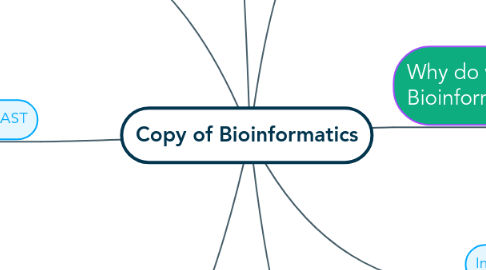Copy of Bioinformatics
par Farisya Ailin


1. What is BLAST
1.1. Abbreviation for Basic Local Alignment Search Tools
1.2. A tool for searching gene or protein sequence databases for related genes interest
1.3. Alignments between the query sequence and any given database sequence, allowing for mismatches and gaps, indicate their degree of similarity
2. What is Bioinformatics?
2.1. Application of computational tools on molecular data
2.1.1. Acquire
2.1.2. Analyze
2.1.3. Visualize such data
2.2. Molecular data
2.2.1. Sequence of DNA
2.2.2. cDNA
2.2.3. Protein
3. How to use BLAST
3.1. DNA sequence obtained from DNA sequencing results must be saved in FASTA format
3.2. Nucleotides or amino acids are represented as single letter codes
3.3. Description always starts with '>'
3.4. Word following '>' is sequence ID without space between them
3.5. No space between nucleotides or amino acids
4. How rDNA technology connected to Bioinfo?
4.1. DNA extraction
4.1.1. From any organisms
4.1.2. Verify the DNA through AGE
4.1.3. Agarose percentage 1/DNA size
4.2. PCR
4.2.1. Amplify targeted DNA sequence using a pair of primers
4.2.2. Verify amplified DNA fragments through AGE
4.3. DNA sequencing
4.3.1. Verify the amplified DNA fragments from PCR through DNA sequencing
4.3.2. Use automated DNA sequencing approach
4.4. Bioinformatics
4.4.1. Interpret message in the DNA sequence
4.4.2. Usage of BLAST program provided by NCBI
4.4.3. Results shown as BLAST output
5. What is NCBI?
5.1. National Centre for Biotechnology Information
5.2. Located in Bethesda, Maryland
5.3. Founded in 1988
5.4. A platform serves as biological database (US)
6. Why do we use Bioinformatics?
6.1. Store biological information (database)
6.2. Retrieve/compare gene sequences
6.3. Predict function of unknown genes/proteins
6.4. Search for previously known function of a gene
6.5. Compare data with other researchers
6.6. Compile/distribute data for other researchers
7. Indentity vs Similarity
7.1. Identity refers to the exact match between two nucleotides or amino acids
7.2. Similarity refers to resemblance between two residues that is greater than one would expect in random
8. What bioinformatics can do?
8.1. Pattern recognition
8.1.1. A particular sequence or structure has been seen before' and that a particular characteristic can be associated with it
8.2. Prediction
8.2.1. From a sequence we can predict the structure and a function
